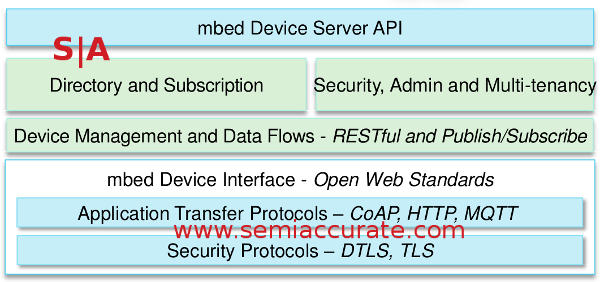![]() ARM is taking the next logical step from their mbed platform with the release of mbed Device Server. If this sounds like a back-end framework for their current IoT device framework, you essentially get it.
ARM is taking the next logical step from their mbed platform with the release of mbed Device Server. If this sounds like a back-end framework for their current IoT device framework, you essentially get it.
If you recall that last year at Techcon, ARM’s mbed platform for IoT was the big news with a bunch of partners lining up to proclaim their eternal love and fealty. One of these partners, Sensinode, provided so called ‘cloud’ connectivity and a back-end server. In the intervening year ARM bought Sensinode and you can probably guess the rest.
With the new mbed Device Server (mDS), ARM is offering a server side framework to complement the mbed sans DS framework on the device side. Now you can program your devices to use a standard back-end server framework that should be fairly portable and widespread. In theory this should make the server side of the client/server duo a piece of cake. It does everything except for the part in the middle, getting from the client to the server and how to do it.

How the stack stacks up
What does ARM plan to do with that API and data layer? What standards will it choose? Will it stick with the Sensinode developed stack or something else? As you can see from the picture above, the stuff in the middle, helpfully color-coded green, is not something ARM is going to take sides on, that is up to the developer to choose how and where to be pointlessly partisan.
Likewise the comms protocols are not their decision, ARM is letting developers pick which stack is right for them. What works for a very local and low power battery operated mesh or point to point setup may not work for a high data rate streaming device. 6LoWPAN, ZigBee IP-NAN, Wi-Fi, BT Smart/Smart IP, Thread, or any others you want to use are welcome. In short pick the best one for your application and then use whatever protocols you want over them, ARM is not picky.
The mbed Device Server is not going to be free and open like mbed but it will be given to developers to develop on after appropriate paperwork has been traded. Once they are ready to deploy the app the Device Server software can be licensed from ARM for undisclosed sums, probably something between the cost of a candy bar and the factory in which it was made, but we could be a little off here.
In the end ARM is trying to bring the RAD world to the server side of the IoT world, not just to throw acronyms at the problem, LOL, but to make ‘cloud’ connectivity for IoT a solved problem. You won’t have to write the plumbing any more, just the app that you want to parse your data. How it gets from your mbed device to your mDS is determined more by the use cases and hardware but there are plenty of options to choose from. Basically last year ARM brought RAD to the IoT device space, this year they are doing the server side.S|A
Charlie Demerjian
Latest posts by Charlie Demerjian (see all)
- ARM ‘cancels’ Qualcomm’s IP license - Oct 23, 2024
- Microsoft Hobbles Intel Once Again - Sep 20, 2024
- What is really going on with Intel’s 18a process? - Sep 9, 2024
- Industry pioneer Mike Magee has passed away - Aug 12, 2024
- What is Qualcomm launching at IFA this year? - Aug 9, 2024